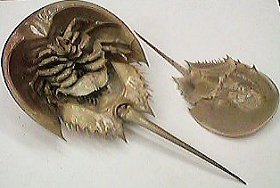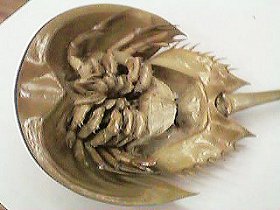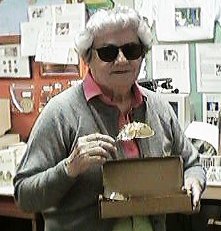The Horseshoe Crab or King Crab
The hosrseshoe crab is called a "living fossil" because it has been on earth for millions of years. Although called a crab, it is not a crustacean, but belongs to the arachnid or spider family.
The male horseshoe crab is smaller than the female horseshoe crab. The body is sometimes two feet long. Alive, it is a brownish-green color. After it dies, the adult is dark brown. They breathe by means of gills attached to the underside of the last pair of abdominal legs. The mouth is on the underside of the center of the body. The eyes are on the top of the front part of the shell.
If horseshoe crabs get turned on their back in the surf and get stranded on the beach, they use their long tail to turn over. If they cannot get turned back over they die. Horseshoe crabs spawn in only two places in the United States. They spawn on the shores of the Delaware Bay, which is between the states of Delaware and New Jersey. The other place is Long Island, New York. [See message from Briana Brown at the bottom of this webpage. She adds much of the New England coast to the list of spawning grounds.] Sometimes their shells are found on other beaches. Most of the time they have died and have just washed up on those beaches. Their spawning time is the last two weeks in May and the first two weeks in June. They crowd up on the beach at high tide. The female scoops out a hole in the sand with the front part of her body and lays thousands of eggs and the male fertilizes them. After they spawn, they go back to the deep water. The eggs look like a very small green sphere. The embryp looks like the adult, but it has its tail folded beside it. Birds fly up from South America, going north to nest. They stop by the Delaware Bay to feast on the horseshoe crab eggs. They eat enough to triple their weight before they continue their journey.
Iona Whitley Many thanks to Mrs. Whitley, one of our Delmar Elementary School mentors, who gave us the horseshoe crabs and this information to include in Benni's box. Hello, I was reading your information about horseshoe crabs and thought that you may want to change the information about spawning grounds. Horseshoe crabs spawn along much of the New England coast, not just in Delaware, New Jersey, and Long Island. I have participated in spawning research studies in Narragansett Bay in Rhode Island, Cape Cod Bay in Massachusetts, and Great Bay in New Hampshire.
Briana Brown
January 20, 2004 I'm a graduate student at the University of Southern Mississippi and my research focuses on the horseshoe crab. Not only does Limulus spawn all along the Atlantic Coast (from Maine to Florida) but Limulus also resides in and spawns along the Gulf of Mexico. Spawning events have been recorded along several beaches of Florida and even along the shores of several barrier islands just off of the Mississippi Gulf coast. Thanks for the informative website, Meagan Williams
Department of Biological Sciences
From: Scott Rubin irubi@pacbell.net Hi, I wanted to let you know that while horseshoe crabs are related to spiders, ticks, and scorpions, they are not in the same family. They are part of the class Merostomata, while spiders, ticks, and scorpions are in the class Arachnida.
Thanks,
Date: Wed, 7 Apr 2004 21:21:07 +0100 (BST) hi Just a note to point out that I am at baldPoint in florida gulf of mexico on the 7th april and the horse shoe crabs are spawning here already. Brian Griffiths
|
| Patricia A. Weeg
The Global Classroom Updated: April 8, 2004 |

 For many years the farmers used the horseshoe crabs for fertilizer. Fishermen used them for eel bait. A scientist at the University of Delaware found that fluid taken from the horseshoe crab will make blood coagulate. Scientists are careful not to harm the horseshoe crabs and put them back in the water.
For many years the farmers used the horseshoe crabs for fertilizer. Fishermen used them for eel bait. A scientist at the University of Delaware found that fluid taken from the horseshoe crab will make blood coagulate. Scientists are careful not to harm the horseshoe crabs and put them back in the water.